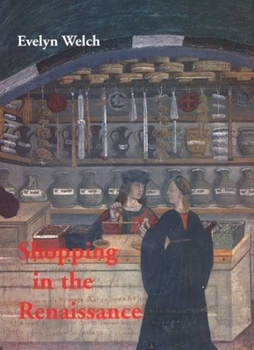Shopping in the Renaissance: Consumer Cultures in Italy, 1400-1600
Select Format
Select Condition 
Book Overview
Shopping was as important in the Renaissance as it is today. This fascinating and original book breaks new ground in the area of Renaissance material culture, focusing on the marketplace and such... This description may be from another edition of this product.
Format:Paperback
Language:English
ISBN:0300159854
ISBN13:9780300159851
Release Date:December 2009
Publisher:Yale University Press
Length:256 Pages
Weight:2.60 lbs.
Dimensions:1.0" x 7.2" x 9.7"
Customer Reviews
1 rating
A Familiar View of an Unfamiliar Locale
Published by Thriftbooks.com User , 18 years ago
Given that much of the lives of us relatively wealthy people is devoted to finding things to buy and then buying them, it is fun to find out how people of different ages and places arranged financial transactions to keep their lives going. It's no surprise that they did a lot differently in Italy five hundred years ago, and not much of a surprise that much is the same. In _Shopping in the Renaissance: Consumer Cultures in Italy 1400 - 1600_, Evelyn Welch has drawn on letters, legal records, paintings, price lists, inventories, architectural plans, and a wide range of other sources to make this basic human activity visible. A problem is that it remains largely invisible; those Italians didn't shop mindlessly, but almost instinctively as we do, with the intricacies of social values involved well below the level of consciousness. Shopping can be opened up, Welch shows, to show the society's thinking and its emphasis on themes like artisanship, labor, honest dealing, and social strata. In Renaissance Italy, shopping was fraught with possibilities of sin. One Lenten sermon reminded hearers that shopping involved misuse of the time God had sacredly granted us, and involved usury. Merchants would habitually do such things as claim their goods were better than they actually were, perhaps even swearing oaths in verification, or they would use false measures. They might even dress misleadingly; in Venice, for instance, it was illegal for a merchant to dress as a peasant to fool buyers that the offered produce was home grown, and those who were re-selling goods on behalf of others were to wear a red "R" on their clothing for _revenditrice_. Dressing wrong was an offense to God: "O merchant," ran one sermon, "if you wish to appear as a merchant, then wear the garment that is made for you." Governments and churches supported efforts to have true weights and measures. This was often difficult, as even within one market merchants would use different measuring systems, and measurements and coinage varied from city to city. It was important for such transactions to be visible, so that both sides would have reason to keep honest, but also would keep to their places. The standard shop was open but had a counter in the front of it; the counter might directly face the street. There was no door or other barrier to prevent a customer from going behind the counter, but it just wasn't done. The customer had to ask to see the goods on display in the shop behind, and the vendor would bring them to the counter, starting the transaction. Who did the shopping? Decent women did not, at least usually. They sent courtiers out to do it, and the courtiers were generally men. The Marchioness of Mantua wrote to her servant Zigliolo in 1491, "These are the kind of things that I wish to have - engraved amethysts, rosaries of black, amber and gold, blue cloth for a camora, black cloth for a mantle, such as shall be without a rival in the world." The household acco





